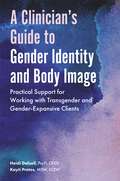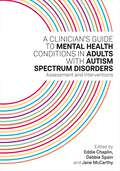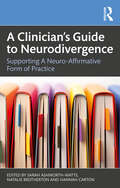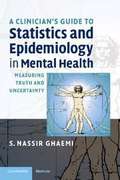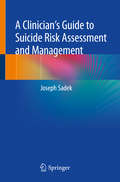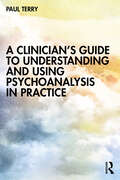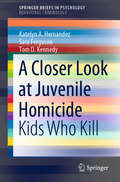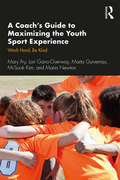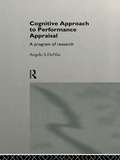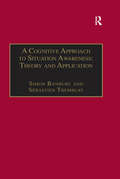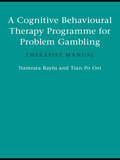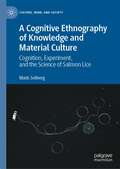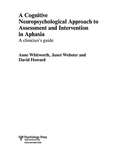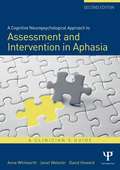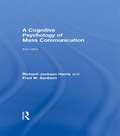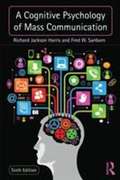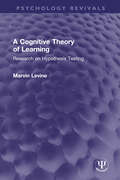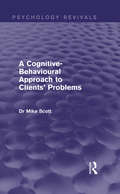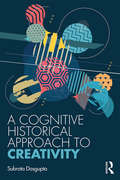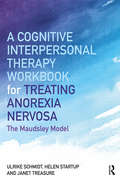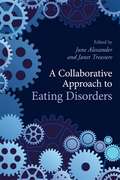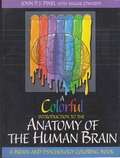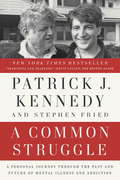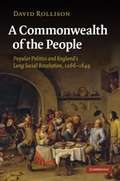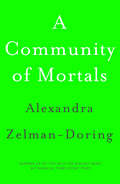- Table View
- List View
A Clinician’s Guide to Gender Identity and Body Image: Practical Support for Working with Transgender and Gender-Expansive Clients
by Heidi Dalzell Kayti ProtosThis accessible guide for clinicians and clinical students working in the fields of eating disorders and transgender health psychology offers useful tips, constructive case studies and reflective questions that enable readers to feel better equipped in supporting their clients' needs.The book addresses the clinical challenges a therapist may encounter, and provides advice on the key issues involved in therapeutic work with transgender, non-binary and gender-expansive clients, including trauma, minority stress, coming out, family support, appearance and body changes. This book will inspire clinicians to bridge the disconnect between the clinical criteria for eating disorders and the type of eating disorder manifesting in a client with co-occurring gender dysphoria.
A Clinician’s Guide to Mental Health Conditions in Adults with Autism Spectrum Disorders: Assessment and Interventions
by David Murphy Colin Hemmings Sarah Bernard Will Mandy Richard Mills Ailsa Russell Kate Johnston Amitta Shah Dene Robertson Daniel Clear Cornelia Carey Karina Marshall-Tate Cristal Oxley Tanja Sappok Dougal Hare Sarah Blainey Freya Rumball Barry Tolchard Sally Cubbin Quinton Deeley Emma Woodhouse Heather Westwood Eleni Paliokosta Manus Moynihan Francisco Musich Cynthia D'Agostino Annelies Spek Michelle Kiep Emmie Neophytou Aida Malovic Clare Melvin Ellie Wilson Joe PowellThis comprehensive and much-needed guide addresses the issues faced by clinicians in assessing and treating the range of mental health conditions, which can affect adults with Autism Spectrum Disorder (ASD). Its particular focus on adults fills a notable gap in the ASD professional literature, with an extensive array of contributors from across the psychology and healthcare professions. Covering a wide variety of common co-occurring mental health conditions including mood disorders, anxiety, psychosis, OCD, personality disorders, and eating disorders, this guide also explores broader issues to do with promoting positive mental health and wellbeing. Authoritative and detailed, this is an essential resource for all clinicians and professionals looking to understand and tailor their approach to mental health in autistic adults, and the need for specific methods and strategies to enhance assessment and treatment.
A Clinician’s Guide to Neurodivergence: Supporting a Neuro-Affirmative Form of Practice
by Sarah Ashworth-WattsA Clinician’s Guide to Neurodivergence: Supporting a neuro-affirmative form of practice is a concise handbook which provides a comprehensive and accessible overview of a range of conditions to support clinicians working with individuals with diverse neurocognitive profiles. It provides a practical guide for clinicians to move towards a more neuro-aware and neuro-affirmative way of working. It sets out guidance around diagnosis and access to services whilst giving consideration to the adaptations and accommodations that might be necessary to avoid the inequities that can often be experienced through neuro-normative or heteronormative practices.Topics covered include learning difficulties such as Dyslexia and Dyscalculia, Autism, ADHD, acquired brain injury and various other neurodivergent profiles. The intersection of neurodivergence with factors such as gender and age and comorbidity with mental health and personality profiles are also considered. Drawing on the NICE guidelines, the International Classification of Disease (ICD) system, and the Diagnostical Statistical Manual (DSM), each chapter provides the background to different neuro-cognitive profiles, common indicators that may be observed, screening and diagnostic assessment, clinical recommendations and signposting to relevant resources and services.It is valuable reading for students, researchers, clinicians, therapists, medical and allied professionals who require an introductory text providing in-depth details regarding a range of neurodivergent conditions.
A Clinician’s Guide to Statistics and Epidemiology in Mental Health
by S. Nassir GhaemiAccessible and clinically relevant, A Clinician's Guide to Statistics and Epidemiology in Mental Health describes statistical concepts in plain English with minimal mathematical content, making it perfect for the busy health professional. Using clear language in favour of complex terminology, limitations of statistical techniques are emphasized, as well as the importance of interpretation - as opposed to 'number-crunching' - in analysis. Uniquely for a text of this kind, there is extensive coverage of causation and the conceptual, philosophical and political factors involved, with forthright discussion of the pharmaceutical industry's role in psychiatric research. By creating a greater understanding of the world of research, this book empowers health professionals to make their own judgments on which statistics to believe - and why.
A Clinician’s Guide to Suicide Risk Assessment and Management
by Joseph SadekThis book offers mental health clinicians a comprehensive guide to assessing and managing suicide risk. Suicide has now come to be understood as a multidimensionally determined outcome, which stems from the complex interaction of biological, genetic, psychological, sociological and environmental factors. Based on recent evidence and an extensive literature review, the book provides straightforward, essential information that can easily be applied in a wide variety of disciplines.
A Clinician’s Guide to Understanding and Using Psychoanalysis in Practice
by Paul TerryThis book provides an intimate portrait of a clinician’s psychoanalytic approach to working in the public health sector with people suffering from acute and chronic emotional pain. Drawing on three central psychoanalytic concepts of countertransference, projective identification, and the destructive superego, Paul Terry weaves together a unique and distinctive psychoanalytically-based approach to psychotherapeutic work. He illustrates this approach in detailed, almost moment-by-moment case studies of his work with people suffering from depression, psychosis, dependency, loneliness, dementia, and terminal illness. He also shows how his approach helps him to understand social and political issues of war, the holocaust, entitlement, and sexual identity. For readers unfamiliar with psychoanalytic theory, the book concludes with an appendix in which there is a summary of some Kleinian psychoanalytic concepts and psychoanalytic studies of psychosis. This informative, compelling, and moving book will act as a valuable resource for students training in psychoanalysis and to work in public settings along with career psychologists and mental health professionals seeking to better understand their clients and experiences.
A Closer Look at Juvenile Homicide: Kids Who Kill (SpringerBriefs in Psychology)
by Sara Ferguson Katelyn A. Hernandez Tom D. KennedyThis book focuses on the small but disturbing percentage of homicides by children that occur each year, providing a brief overview of the legal, individual, and social aspects of this phenomenon. Since the 1980s, these crimes have been on the rise and the resulting legal response has been harsher punishments as well as treatment of children like adults. This has led to a host of failures in the juvenile justice system wherein recidivism is high and general outcome is low. The book reviews the literature on youth homicide, including gender, age, and race factors, as well as individual, familial, and environmental risks. The authors seek to aid in the identification and understanding of juvenile homicide to raise awareness of both a population that receives little formal psychological intervention and of the systemic deficiencies that affect these individuals as well as society itself. Exploring current theories, trends, and common factors in juvenile homicide, this brief aims to improve prevention, intervention, and reintegration of young offenders into the community.
A Coach’s Guide to Maximizing the Youth Sport Experience: Work Hard, Be Kind
by Mary Fry Lori Gano-Overway Marta Guivernau Mi-Sook Kim Maria NewtonThis book guides sport coaches, parents and administrators in creating a caring and task-involving sport climate that helps athletes perform their best and have an enjoyable and meaningful sport experience. It introduces the concept of a caring and task-involving climate and provides a "how to" guide to creating this climate in sport. Firstly, this guide introduces the caring and task-involving climate and summarizes research highlighting its many benefits. Secondly, the five features of this climate are presented along with the reflective exercises for developing them within a team. Coaches will see strategies in action, sample conversations, and a variety of ways to implement the features of a caring and task-involving experience. By describing how it may be implemented and methods for overcoming possible challenges, this book finally highlights how parents and sport administrators can support the creation and preservation of caring and task-involving climates. By helping teams develop caring climates that optimize athletes’ sport experience and performance, this book is essential reading for coaches, sport administrators, parents, and sport psychology practitioners. It will also be of great interest to those who have minimal training in sport psychology, but who are involved in sport at many levels, such as youth and high school.
A Cognitive Approach to Performance Appraisal (People and Organizations)
by Angelo DeNisiThe benefits of performance appraisal in the business world have caused an upsurge of books and programs for use in management, but few of the methods described bother to verify that the underlying psychology on which they are based holds true. Angelo DeNisi has spent 10 years conducting research into cognitive processes, particularly those of the rater, in performance appraisal. A Cognitive Appraisal is a careful and thorough investigation of appraisal decisions. Based on experiments conducted with over 300 participants, Angelo DeNisi presents results from both the laboratory and real life settings into this vital area. The evidence described will be invaluable to all those involved in assessing the validity of particular performance 'packages' for use by themselves or their clients and to other researchers in appraisal techniques. It is also an excellent guide for all psychologists who wish to verify their results in the field as it contains the story of a long term research program encompassing the move from lab to field, successfully.
A Cognitive Approach to Situation Awareness: Theory and Application
by Sébastien TremblayThe importance of 'situation awareness' (SA) in assessing and predicting operator competence in complex environments has become increasingly apparent in recent years. It has been widely established that SA is a contributing factor to many commercial and military accidents and incidents. Yet determining exactly what constitutes SA is a very difficult task, given the complexity of the construct itself, and the many different processes involved with its acquisition and maintenance. This volume brings together recent developments from researchers and practitioners from around the world who are studying and applying SA from a cognitive perspective. The 41 contributors represent many different theoretical perspectives, research approaches and domains of application. Each chapter has a primary emphasis around one of three main topics - theory, measurement and application and examines the considerable inter-linkage between them. To bring further coherence to the book, all of the contributors received draft manuscripts of those chapters most relevant to their own. Designed to be completely international and interdisciplinary, the authors themselves present varied perspectives from academic departments and industrial organisations from around the world, and from broad applications - with contributions from researchers in the domains of process control, sport, aviation, transportation, and command and control. The readership includes practitioners, academics and researchers within human factors, ergonomics and industrial psychology; Graduate and Undergraduate students specialising within these areas during their final year.
A Cognitive Behavioural Therapy Programme for Problem Gambling: Therapist Manual
by Namrata Raylu Tian Po OeiThis book is a treatment manual providing guidance for therapists treating clients with gambling addictions. In this book the authors use a cognitive behavioural approach and provide a session by session guide for overcoming problem gambling. Essential topics covered include: assessment and psychoeducation cognitive behavioural strategies to stabilize gambling identifying and challenging thinking errors relaxation and imaginal exposure problem solving and goal setting managing negative emotions relapse prevention: maintaining a balanced lifestyle and coping with high risk situations A Cognitive Behavioural Therapy Programme for Problem Gambling supplies detailed information to help the therapist and client understand gambling behaviours, as well as practical advice on techniques that can be used with the client to change these behaviours. This practical guide includes handouts and exercises that can be downloaded by purchasers of the print edition. It will provide helpful guidance for addiction counsellors and therapists worldwide.
A Cognitive Ethnography of Knowledge and Material Culture: Cognition, Experiment, and the Science of Salmon Lice (Culture, Mind, and Society)
by Mads SolbergThis cognitive ethnography examines how scientists create meaning about biological phenomena through experimental practices in the laboratory, offering a frontline perspective on how new insights come to life. An exercise in the anthropology of knowledge, this story follows a community of biologists in Western Norway in their quest to build a novel experimental system for research on Lepeoptheirus salmonis, a parasite that has become a major pest in salmon aquaculture. The book offers a window on the making of this material culture of science, and how biological phenomena and their representations are skillfully transformed and made meaningful within a rich cognitive ecology. Conventional accounts of experiments see their purpose as mainly auxiliary, as handmaidens to theory. By looking closely at experimental activities and their materiality, this book shows how experimentation contributes to knowledge production through a broader set of epistemic actions.In drawing on a combination of approaches from anthropology and cognitive science, it offers a unique contribution to the fields of cultural psychology, psychological anthropology, science and technology studies and the philosophy of science.
A Cognitive Neuropsychological Approach to Assessment and Intervention in Aphasia: A Clinician's Guide
by David Howard Anne Whitworth Janet WebsterThis book provides both a theoretical and practical reference to cognitive neuropsychological approaches to speech and language therapists working with people with aphasia. Having evolved from the activity of a group of clinicians working with people with aphasia, it is a highly practical guide that aims to interpret the theoretical literature as it relates to aphasia and link it directly to available assessment tools and therapy techniques. The opening section of the book provides an overview of the theory underpinning the approach and how it can be applied to the assessment and interpretation of language-processing impairments. The second section offers a working explanation of different components of language processing, outlining the deficits that may arise from impairment to each component. In addition, the clinician is guided to available assessments to test out clinical hypotheses and offered interpretations of performance patterns. The final section provides a comprehensive overview of the therapy literature with systematic summaries of the therapies undertaken and a synthesis of the findings to date. This book has been written by clinicians with hands-on experience. It will be an invaluable resource for clinicians and students of speech and language therapy and related disciplines.
A Cognitive Neuropsychological Approach to Assessment and Intervention in Aphasia: A clinician's guide
by David Howard Anne Whitworth Janet WebsterThis is a second edition of the highly popular volume used by clinicians and students in the assessment and intervention of aphasia. It provides both a theoretical and practical reference to cognitive neuropsychological approaches for speech-language pathologists and therapists working with people with aphasia. Having evolved from the activity of a group of clinicians working with aphasia, it interprets the theoretical literature as it relates to aphasia, identifying available assessments and published intervention studies, and draws together a complex literature for the practicing clinician. The opening section of the book outlines the cognitive neuropsychological approach, and explains how it can be applied to assessment and interpretation of language processing impairments. Part 2 describes the deficits which can arise from impairments at different stages of language processing, and also provides an accessible guide to the use of assessment tools in identifying underlying impairments. The final part of the book provides systematic summaries of therapies reported in the literature, followed by a comprehensive synopsis of the current themes and issues confronting clinicians when drawing on cognitive neuropsychological theory in planning and evaluating intervention. This new edition has been updated and expanded to include the assessment and treatment of verbs as well as nouns, presenting recently published assessments and intervention studies. It also includes a principled discussion on how to conduct robust evaluations of intervention within the clinical and research settings. The book has been written by clinicians with hands-on experience. Like its predecessor, it will remain an invaluable resource for clinicians and students of speech-language pathology and related disciplines, in working with people with aphasia.
A Cognitive Psychology of Mass Communication
by Richard Jackson Harris Fred W. SanbornA Cognitive Psychology of Mass Communication is the go-to text for any course that adopts a cognitive and psychological approach to the study of mass communication. In its sixth edition, it continues its examination of how our experiences with media affect the way we acquire knowledge about the world, and how this knowledge influences our attitudes and behavior. Using theories from psychology and communication along with reviews of the most up-to-date research, this text covers a diversity of media and media issues ranging from commonly discussed topics, such as politics, sex, and violence, to lesser-studied topics, such as sports, music, emotion, and prosocial media. This sixth edition offers chapter outlines and recommended readings lists to further assist readability and accessibility of concepts, and a new companion website that includes recommended readings, even more real-world examples and activities, PowerPoint presentations, sample syllabi, and an instructor guide.
A Cognitive Psychology of Mass Communication (Sixth Edition)
by Richard Jackson Harris Fred W. SanbornA Cognitive Psychology of Mass Communicationis the go-to text for any course that adopts a cognitive and psychological approach to the study of mass communication. In its sixth edition, it continues its examination of how our experiences with media affect the way we acquire knowledge about the world, and how this knowledge influences our attitudes and behavior. Using theories from psychology and communication along with reviews of the most up-to-date research, this text covers a diversity of media and media issues ranging from commonly discussed topics, such as politics, sex, and violence, to lesser-studied topics, such as sports, music, emotion, and prosocial media. This sixth edition offers chapter outlines and recommended readings lists to further assist readability and accessibility of concepts, and a new companion website that includes recommended readings, even more real-world examples and activities, PowerPoint presentations, sample syllabi, and an instructor guide.
A Cognitive Theory of Learning: Research on Hypothesis Testing (Psychology Revivals)
by Marvin LevineFirst published in 1975, A Cognitive Theory of Learning provides a history of hypothesis theory (H theory), along with the author’s research from the previous decade. The first part introduces the reader to contributions of some major learning theorists. It traces the history of H theory, reviewing the confrontation with conditioning theory, with the stress on the emergence of H theory which came to predominate. The second part describes the author’s work, presented as it emerged over time. It shows how the outcome of one experiment typically led to the next theoretical development or experiment. Originally part of The Experimental Psychology Series this reissue can now be read and enjoyed again in its historical context.
A Cognitive-Behavioural Approach to Clients' Problems (Psychology Revivals)
by Michael J. ScottThe most useful therapy is one that can be applied to a wide range of client problems, is easy to learn, and produces lasting results following a brief intervention. The cognitive-behavioural approaches described in this volume probably come nearest to this ideal. Originally published in 1989, this book begins with a description of the cognitive-behavioural revolution that had taken place in the decade prior to publication and provides therapists with the specifics of helping in four major areas: child behaviour problems, emotional disorders (depression and anxiety), interpersonal problems and addictive disorders. Coverage of the major areas of concern begins in each case with an overview of theory and research in the specific domain, followed by detailed guidance for practice. The volume represents a synthesis of the author’s research and practice with patients in inner city Liverpool and with employees referred by major employers. The strategies described have been devised to take account of a wide variety of client social contexts and service delivery settings, and the strengths, pitfalls and practicalities of group cognitive-behavioural approaches are also discussed. The reader is finally led into largely uncharted waters, the application of cognitive-behavioural approaches to schizophrenia, people with learning difficulties and the elderly. Back in print, this title will still be of interest to students and practitioners in social work, clinical psychology, and community psychiatry.
A Cognitive-Historical Approach to Creativity
by Subrata DasguptaAt the heart of creativity is the practice of bringing something new into existence, whether it be a material object or abstract idea, thereby making history and enriching the creative tradition. A Cognitive Historical Approach to Creativity explores the idea that creativity is both a cognitive phenomenon and a historical process. Blending insights and theories of cognitive science with the skills, mentality and investigative tools of the historian, this book considers diverse issues including: the role of the unconscious in creativity, the creative process, creating history with a new object or idea, and the relationship between creators and consumers. Drawing on a plethora of real-life examples from the eighteenth century through to the present day, and from distinct fields including the arts, literature, science and engineering, Subrata Dasgupta emphasizes historicity as a fundamental feature of creativity. Providing a unified, integrative, interdisciplinary treatment of cognitive history and its application to understanding and explaining creativity in its multiple domains, A Cognitive Historical Approach to Creativity is essential reading for all researchers of creativity.
A Cognitive-Interpersonal Therapy Workbook for Treating Anorexia Nervosa: The Maudsley Model
by Janet Treasure Ulrike Schmidt Helen StartupBased on the authors' pioneering work and up-to-date research at London's Maudsley hospital, A Cognitive Interpersonal Therapy Workbook for Treating Anorexia Nervosa provides adults with anorexia nervosa and the professionals working alongside them with a practical resource to work through together. The approach described is recommended by the National Institute of Clinical and Care Excellence (NICE) as a first-line, evidence-based treatment for adults with anorexia nervosa. A Cognitive Interpersonal Therapy Workbook for Treating Anorexia Nervosa provides adults with anorexia nervosa and the professionals working alongside them with a practical resource to work through together. The manual is divided into accessible modules, providing a co-ordinated, step-by-step guide to recovery. Modules include: Nutrition Developing treatment goals Exploring thinking styles Developing an identity beyond anorexia. A Cognitive Interpersonal Therapy Workbook for Treating Anorexia Nervosa is a highly beneficial aid to recovery for those with the condition, their families and mental health professionals.
A Collaborative Approach to Eating Disorders
by Janet Treasure June AlexanderWhile many aspects of eating disorders remain a mystery, there is growing evidence that collaboration is an essential element for treatment success. This book emphasises and explains the importance of family involvement as part of a unified team approach towards treatment and recovery. A Collaborative Approach to Eating Disorders draws on up-to-date evidence based research as well as case studies and clinical vignettes to illustrate the seriousness of eating disorders and the impact on both the sufferer and their loved ones. Areas of discussion include: current research including genetic factors, socio-cultural influences and early intervention clinical applications such as family based dialectical and cognitive behavioural treatments treatment developments for both adolescents and adults with a range of eating disorders building collaborative alliances at all levels for treatment and ongoing recovery. With contributions from key international figures in the field, this book will be a valuable resource for students and mental health professionals including family doctors, clinicians, nurses, family therapists, dieticians and social workers.
A Colorful Introduction to the Anatomy of the Human Brain: A Brain and Psychology Coloring Book
by John P.J. Pinel Maggie E. EdwardsThousands of people inquire about and buy a competitor to this book each year. Unique layout compared to the competition! Text is on the left page with illustration on facing page. A cover flap can cover the illustration's labels for easy self-testing. Up-to-date information covers the latest findings. Available now! Acknowledging the difficulty many readers have when first attempting to learn about the brain's psychological functions, the authors of A Colorful Introduction to the Human Brain have created a book that makes the fascinating world of brain psychology research accessible to readers with little or no background in neuroscience. Readers learn the material in several steps. First they read through the introduction and definitions on the left page; then they color the illustration on the facing page; and finally they use the special cover flap to conceal the illustration labels while checking their knowledge, until they feel they have completely learned the material. Review exercises at the end of each chapter provide an opportunity for self-assessment, with answers provided at the end of the book. <P><P> John Pinel, a professor of biopsychology at the University of British Columbia, is an award-winning teacher and the author of over 200 scientific articles. However, he is best known for his reader-oriented writing. His clear concise introductions to behavioral neuroscience have inspired, enthralled, and amused a generation of students and lay people.
A Common Struggle: A Personal Journey Through the Past and Future of Mental Illness and Addiction
by Stephen Fried Patrick J. Kennedy**A New York Times Bestseller**Patrick J. Kennedy, the former congressman and youngest child of Senator Ted Kennedy, details his personal and political battle with mental illness and addiction, exploring mental health care's history in the country alongside his and every family's private struggles.On May 5, 2006, the New York Times ran two stories, "Patrick Kennedy Crashes Car into Capitol Barrier" and then, several hours later, "Patrick Kennedy Says He'll Seek Help for Addiction." It was the first time that the popular Rhode Island congressman had publicly disclosed his addiction to prescription painkillers, the true extent of his struggle with bipolar disorder and his plan to immediately seek treatment. That could have been the end of his career, but instead it was the beginning. Since then, Kennedy has become the nation's leading advocate for mental health and substance abuse care, research and policy both in and out of Congress. And ever since passing the landmark Mental Health Parity and Addiction Equity Act--and after the death of his father, leaving Congress--he has been changing the dialogue that surrounds all brain diseases.A Common Struggle weaves together Kennedy's private and professional narratives, echoing Kennedy's philosophy that for him, the personal is political and the political personal. Focusing on the years from his 'coming out' about suffering from bipolar disorder and addiction to the present day, the book examines Kennedy's journey toward recovery and reflects on Americans' propensity to treat mental illnesses as "family secrets."Beyond his own story, though, Kennedy creates a roadmap for equality in the mental health community, and outlines a bold plan for the future of mental health policy. Written with award-winning healthcare journalist and best-selling author Stephen Fried, A Common Struggle is both a cry for empathy and a call to action. From the Hardcover edition.
A Commonwealth of the People
by David RollisonIn 1500 fewer than three million people spoke English; today English speakers number at least a billion worldwide. This book asks how and why a small island people became the nucleus of an empire 'on which the sun never set'. David Rollison argues that the 'English explosion' was the outcome of a long social revolution with roots deep in the medieval past. A succession of crises from the Norman Conquest to the English Revolution were causal links and chains of collective memory in a unique, vernacular, populist movement. The keyword of this long revolution, 'commonwealth', has been largely invisible in traditional constitutional history. This panoramic synthesis of political, intellectual, social, cultural, religious, economic, literary and linguistic movements offers a 'new constitutional history' in which state institutions and power elites were subordinate and answerable to a greater community that the early modern English called 'commonwealth' and we call 'society'.
A Community of Mortals
by Alexandra Zelman-DoringWhat is it like to have someone die in your arms? Can we return from the dead? And why has nobody heard of therapeutic hypothermia? Forced to come to terms with doctors pronouncing her husband ‘clinically dead’, Alexandra Zelman-Doring embarks on an exploration of what death means to us and how we might face it. Initally she is overwhelmed by the difficulty of accepting the loss of a loved one, and the anger, sadness and sense of isolation that it brings. But her suffering pushes her towards a life-store of reading, and here she finds words with which to contemplate death; from Turgenev on death as an ‘unanswerable reproach’ to Norbert Elias on the extraordinary collective will to endure it.Equally inspiring are the true stories of unlikely survivors: from a species of frog whose organs stop, frozen, throughout the winter, only to stir back to life in the spring, to Anna Bagenholm whose iced brain and body held out against all odds after a fatal accident. These incidents inform a development in medical science where cardiac arrest is treated with ‘therapeutic hypothermia’, in some cases allowing the body to last without oxygen just long enough for doctors to return the near-dead to life.
